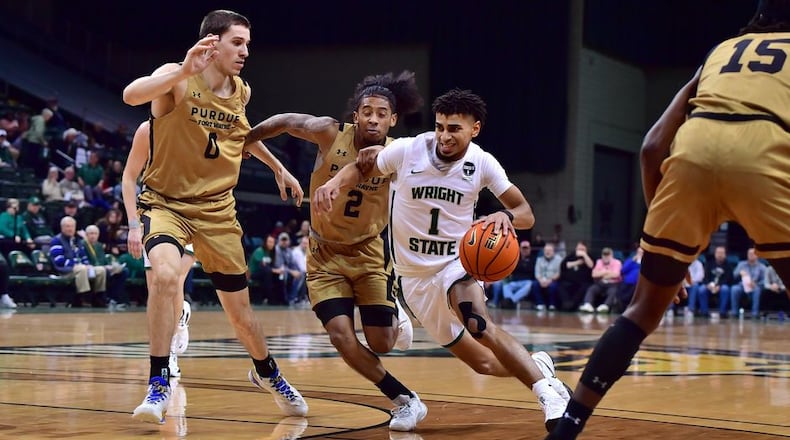Drey Carter’s first shot at a Division-I full ride came from Wright State in June before his senior year. By the time he committed to the Raiders in November, his scholarship tally was at 15.
Mid-majors — and perhaps even high majors — missed on Brandon Noel. The Chillicothe star was being wooed only by D-II schools when Wright State offered, and he committed just as the chase was beginning to heat up.
“That happens a lot. It’s one of the reasons why we’re slow to offer kids. You look at so many of our top kids, and very few people recruited them (before Wright State showed interest),” Nagy said.
“Hardly anyone recruited Loudon. Hardly anybody recruited Grant. Trey didn’t have a ton of recruiting. Tanner had hardly any recruiting. We can go down the list.”
Loudon Love, Trey Calvin and Tanner Holden are in the top 12 in career scoring at the school, and Grant Basile is 22nd.
“I think that’s probably where we’ve done a really good job: evaluating. But we have to be careful with the offers we put out, particularly those who don’t have any. As soon as that happens, they all come in,” Nagy said.
“Teams see what we’ve done, and they go, ‘Well, he must be a good player. We’d better go after him.’”
The Raiders aren’t just looking at a recruit’s current skill set, but making projections on what he can become. And he’ll often need a redshirt year to reach his full potential.
Nagy probably has had more players sit out a season than any other Horizon League coach. He redshirted 10 in his first seven years, including Carter and Logan Woods last season, and at least two of the four incoming freshmen likely will take a redshirt year.
It may be a tough sell at first, but Nagy’s pitch to those players is hard to refute.
“What you’re exchanging is a fifth year vs. a first year,” Nagy said. “The fifth year, we’d hope you’re playing 35 minutes a game. The first year, you’re playing five minutes a game.
“But we don’t force them. We talk it through with them and say, ‘This is the way we see it. This is our experience in the past. These are the guys who have done it, and look at them.’”
Love took that first year to get fit and strong, and he was a two-time league player of the year.
Basile’s redshirt year was due to some ankle issues, but he also blossomed into a star before transferring to Virginia Tech as a senior.
Sophomore Brandon Noel had TWO redshirt years, one for a knee injury and the second because he said he didn’t ‘feel up to speed mentally or physically.”
The 6-foot-8 forward finally played last season and was the league freshman of the year.
“They were difficult,” he said of those years. “But at the end of the day, I wouldn’t change it.
“It made me stronger and made me tougher and really helped me last year. I think a lot of people would agree with that.”
Some redshirted players end up transferring — Jaylon Hall went to Morehead State, Andre Harris to Navarro College and then Notre Dame College in Ohio and Everett Winchester to Florida Atlantic — but there have been more hits than misses.
One player who looked destined to redshirt but didn’t was 6-9 junior center A.J. Bruan.
The Raiders lost five of their first six games in 2021-22 while Braun sat out. But Nagy inserted the freshman in the starting lineup out of desperation at Purdue Fort Wayne, and he responded with 17 points on 8-of-9 shooting.
He ended up making the league all-freshman team.
But having to remove Braun’s redshirt still gnaws at Nagy.
“A.J.’s freshman year, we tried, and now you look back and think, ‘Man, if we would’ve redshirted him, he’d just be a sophomore now instead of a junior.’ You look — particular with our ‘bigs’ — at the success they’ve had when they’ve redshirted,” he said.
“Most of them don’t (like it). It’s not easy. But the year gets over very quickly, and then you’re just like everyone else again. And you’re still a freshman.”
About the Author
